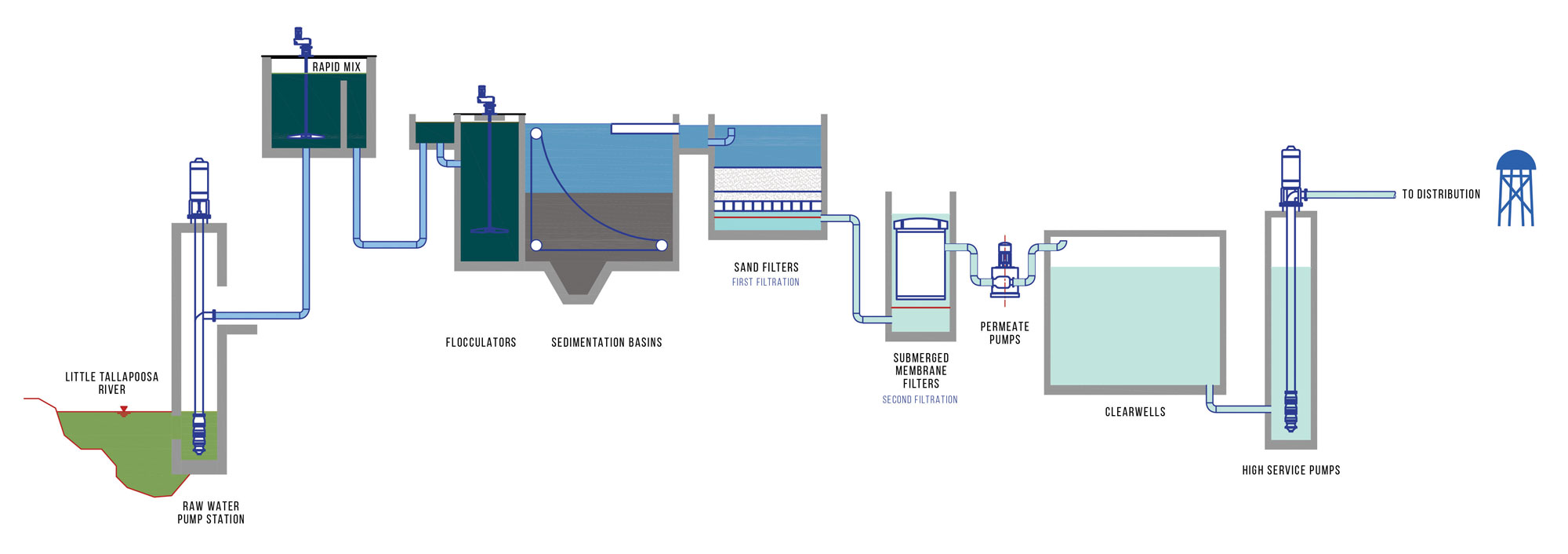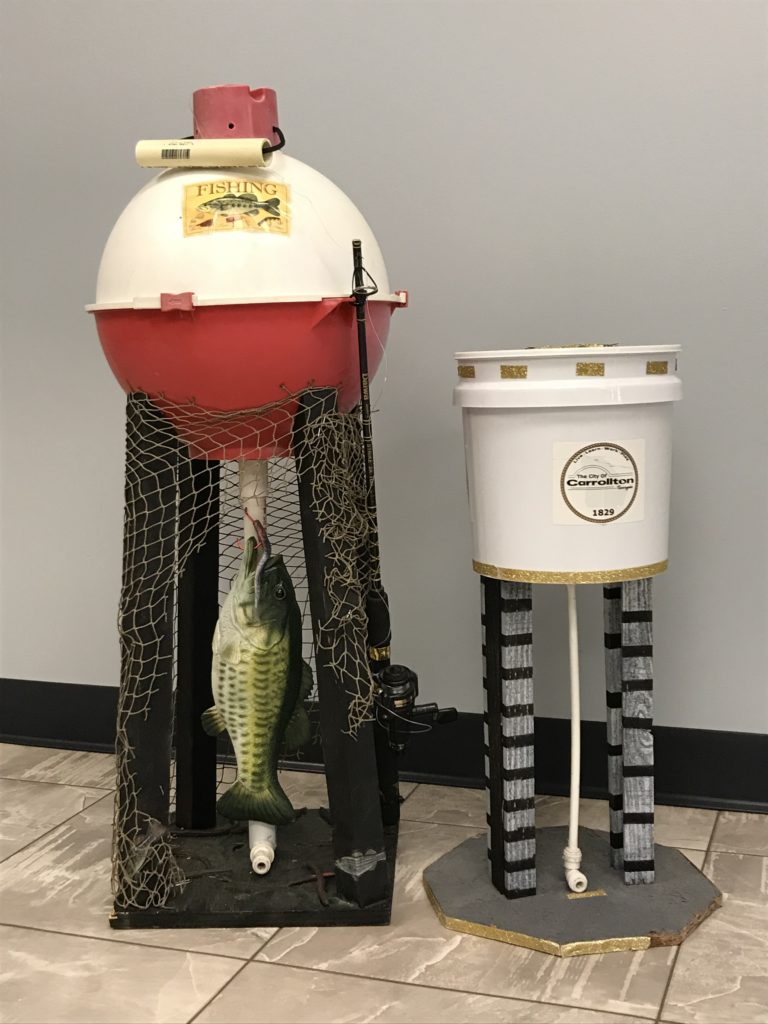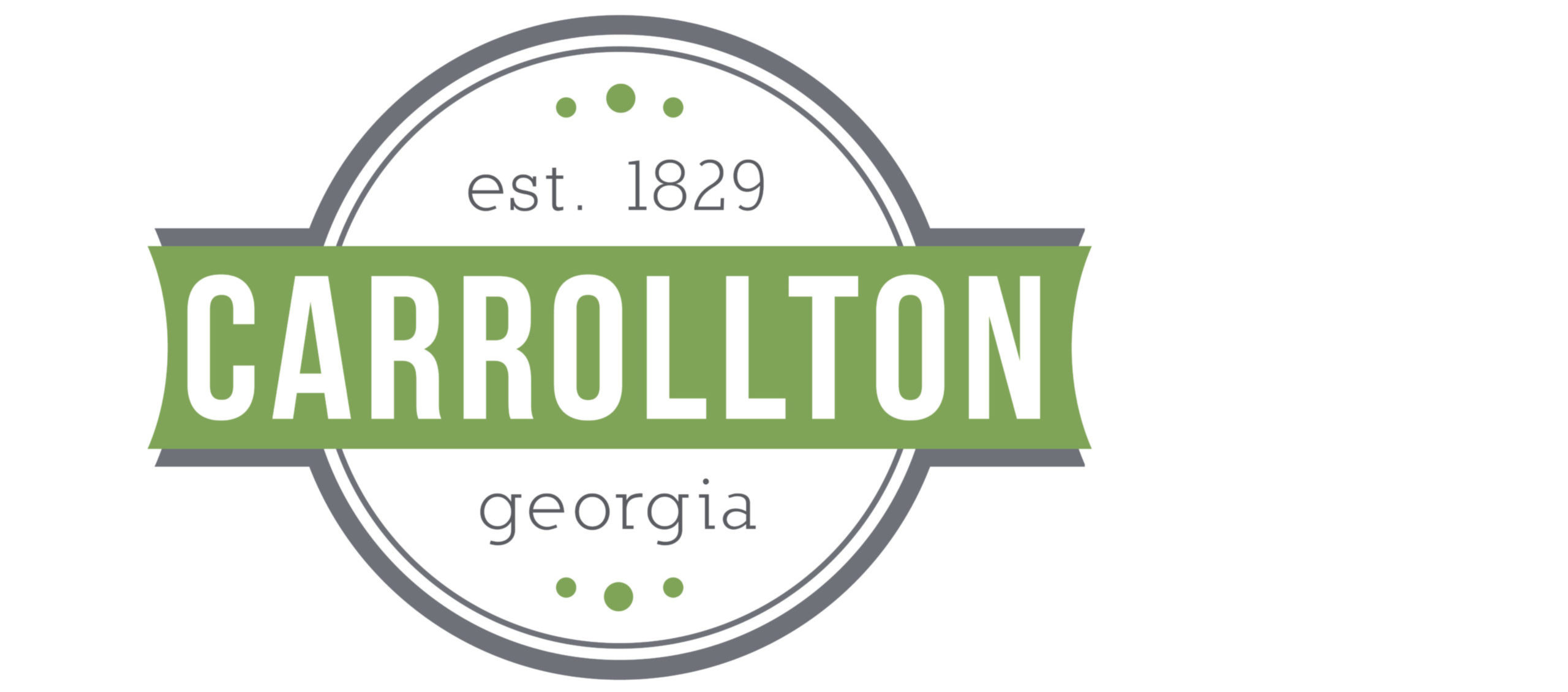
The City of Carrollton’s Water Treatment Department is committed to providing residents with the highest quality drinking water that meets or exceeds all state and federal standards. Carrollton has earned a long list of awards, including Best Tasting Tap Water in the state. As new challenges to drinking water safety emerge, we remain dedicated to protecting our water sources, water conservation and community education.
Below, you will find detailed testing information and water quality data from January 1 through December 31, 2023.
Carrollton’s Water Filtration Process

The City of Carrollton draws its water from the Little Tallapoosa River.
We also have three reservoirs:
- Lake Buckhorn, through which the Little Tallapoosa River runs
- Sharp Creek Reservoir, which flows into the Little Tallapoosa River
- Lake Carroll, which flows into Curtis Creek, then flows into the Little Tallapoosa River
Sampling Results
During the past year, we have collected thousands of water samples to determine the presence of microbiological, organic, inorganic and volatile organic contaminants. The charts below show only those contaminants that were detected in our water. All of the substances listed are below the Maximum Contaminant Level (MCL), but we feel it is important that you know exactly what was detected and how much of the substance was present
Contaminant (units) | Year | MCL | MCLG | Average Results | Range Detected | Meets EPA Standard | Major Sources |
Chlorine (ppm) | 2023 | 4 | 4 | 1.61 | 1.10 - 1.94 | Yes | Water additive used to control microbes |
Fluoride (ppm) | 2023 | 4 | 4 | 0.71 | 0.40 - 0.86 | Yes | Water additive which promotes strong teeth |
Haloacetic Acids (HAA’s) (ppb) | 2023 | 60 | N/A | 18.4375 | 15 - 28 | Yes | By-product of drinking water disinfection |
Total Trihalomethanes (TTHM’s) | 2023 | 80 | N/A | 30 | 20 - 50 | Yes | By-product of drinking water disinfection |
Total Organic Carbon (ppm) | 2023 | TT | N/A | 1.5 | 1.2 - 1.7 | Yes | Naturally present in the environment |
Nitrate/Nitrite (ppm) | 2023 | 10 | 10 | 0.32 | 0.32 | Yes | Runoff from fertilizer use, leaching from septic tanks, sewage, erosion of natural deposits |
Turbidity (NTU) | 2023 | TT=0.15 NTU 95% Samples ≤0.10 NTU | 100% | 0.03 | 0.01 - 0.08 | Yes | Soil runoff |
Contaminant (units) | Year Sampled | Action Level | MCLG | Amount Detected 90th% | Sites Above Action Level | Meets EPS Standards | Typical Source |
Lead(ppb) | 2023 | 15 | 0 | 6.8 ppb | 0 | Yes | Corrosion of household plumbing systems |
Copper (ppm) | 2023 | 1.3 | 1.3 | 0.13 ppm | 0 | Yes | Corrosion of household plumbing systems |
Get Involved
Learn more about city initiatives and opportunities for community involvement during our Mayor and Council meetings, held the first Monday of each month at 6pm at the Public Safety Complex. For meeting information and agenda details, visit carrolltonga.com.

Carrollton hosts, in collaboration with GAWP and GAWWA, the Georgia Model Water Tower Competition each year. Students learn about engineering design while being introduced to some of the careers available in the water profession. The students compete individually or in teams to design and build working model water towers, which are tested and judged on competition day.
Come see first-hand how the water treatment and testing process works. Upon request, we offer tours to schools, colleges, universities and to the general public. To schedule a tour, contact us at 770-830-2021.
Sustainable Efforts
Maintaining the City of Carrollton’s water system requires ongoing upkeep of storage tanks, routine sampling and flushing the lines and fire hydrants. Our water system contributes to the Fire Department’s Insurance Service Office’s top rating of Class 1. This rating is earned by fewer than 1/4 of one percent of fire departments nationwide and saves residents money in insurance costs.
Water Conservation Tips

Pollution and Contaminants
Drinking water comes from rivers, lakes, streams, ponds, reservoirs, springs and wells. The categories of potential pollution sources found in the Source Water Assessment are animal feed lots, non-point storm water, airports, hazardous waste facilities and roads that cross over streams. As water travels over the surface of the land or through the ground, it dissolves naturally-occurring minerals and, in some cases, radioactive material, and can pick up substances resulting from animal or human activity. Contaminants that may be present in source water include microbial contaminants, inorganic contaminants, pesticides and herbicides, organic chemical contaminants and radioactive contaminants.
Lead in Drinking Water
If present, elevated levels of lead can cause serious health problems, especially for pregnant women and young children. Lead in drinking water is primarily from materials and components associated with service lines and home plumbing. The city is responsible for providing high quality drinking water, but cannot control the materials used in plumbing components.
When water has been sitting for several hours, minimize the potential for lead exposure by flushing the tap for 30 seconds to 2 minutes before using water for drinking or cooking. If you have concerns about lead in your water, consider having your water tested. Information on lead in drinking water, testing methods and steps to minimize exposure is available from the Safe Drinking Water Hotline 800-426-4791 or epa.gov/safewater/lead.
Important Health Information
Drinking water, including bottled water, may reasonably contain at least small amounts of some contaminants. The presence of contaminants does not necessarily indicate that water poses a health risk. More information about contaminants and potential health effects can be obtained by calling the USEPA’s Safe Drinking Water Hotline 800-426-4791.
Some people may be more vulnerable to contaminants in drinking water than the general population. Immuno-compromised persons such as persons with cancer undergoing chemotherapy, persons who have undergone organ transplants, people with HIV/AIDS or other immune system disorders, some elderly, and infants may be particularly at risk from infections. These people should seek advice from their health care providers about drinking water. The U.S. EPA/CDC (Centers for Disease Control and Prevention) guidelines on appropriate means to lessen the risk of infection by Cryptosporidium and other microbial contaminants are available from the Safe Drinking Water Hotline at 800-426-4791.
To ensure that tap water is safe to drink, EPA prescribes regulations which limit the amount of certain contaminants in water provided by public water systems. Food and Drug Administration regulations establish limits for contaminants in bottled water which must provide the same protection for public health.
